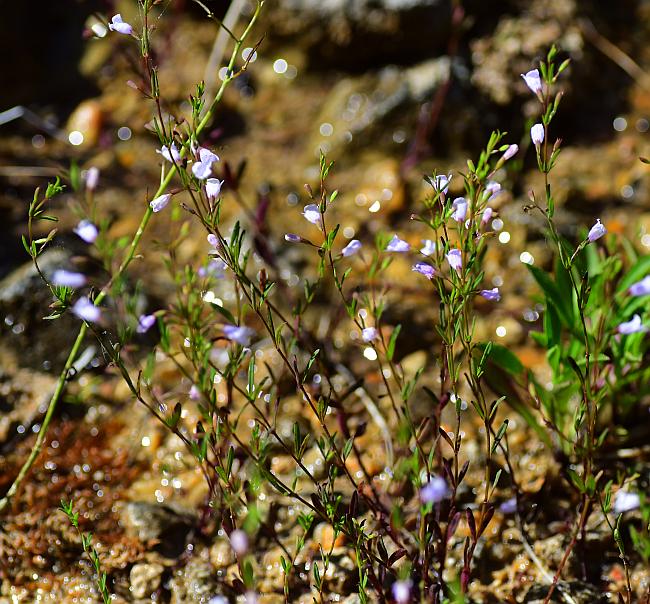Clinopodium arkansanum (Nutt.) House
Arkansas Calamint

Native
CC = 7
CW = 0
MOC = 33
© SRTurner
Clinopodium arkansanum (Nutt.) HouseArkansas Calamint | |
 |
Native CC = 7 CW = 0 MOC = 33 |
© SRTurner |
|
Family - Lamiaceae Habit - Perennial forb, with fibrous roots and slender rhizomes which usually develop from stolons of previous years, usually forming loose colonies. Plants with strong minty fragrance. Stems - Stems dimorphic, glabrous except for sparse, minute hairs at some nodes. Basal branches formed after flowering, 1-10 cm long, stoloniferous, prostrate, rooting at the tip and some nodes, unbranched or few-branched. Flowering stems 10-40 cm long, erect or strongly ascending, 4-angled, glabrous, usually much-branched, glandular punctate.
Leaves - Opposite, somewhat dimorphic, simple, entire, glabrous, sometimes reddish- or purplish-tinged (especially along the stolons), the sessile glands relatively conspicuous, with a strong, pleasant fragrance when crushed, those of the basal branches and sometimes also the basal portion of the flowering stems 3-10 mm long, short- to long-petiolate (the petiole shorter than to as long as the blade), the blade elliptic to ovate or nearly circular, relatively thick, rounded to angled at the base and tip, grading abruptly into the main leaves of the flowering stems, these 4-22 mm long, sessile or very short-petiolate, linear to narrowly oblanceolate, relatively thin, tapered at the base, angled or tapered to the rounded or bluntly to less commonly sharply pointed tip, densely glandular punctate on both surfaces.
Inflorescence - Axillary clusters of 2-8 flowers per node, the stalks glabrous, 3-10 mm long, the bracts 1-4 mm long, linear to threadlike.
Flowers - Calyces 4-6 mm long, bilabiate, symmetric at the base, not pouched, glabrous externally except for the relatively conspicuous sessile glands between the ribs, glandular punctate, with 13 ribs, the lobes narrowly triangular to triangular, straight or sometimes somewhat spreading at fruiting. Upper lip 3-lobed, lower lip 2-lobed. Lobes acuminate, 1.1-1.2mm long. Calyx with a ring of floccose hairs at the summit of the tube internally. Corollas 8-15 mm long, the lips about half as long as the tube, purplish (very rarely all white), bilabiate. Upper lip single-lobed, the lobe deflexed, 3-4 mm broad, 2-3 mm long, apically notched. Lower lip 3-lobed, the lobes rounded, 2 mm long and broad, the center lobe slightly larger than the laterals. Stamens 4, didynamous, 2 attached in the basal 1/4 of the corolla tube, 2 attached in the apical 1/4 of the corolla tube and slightly exserted. Filaments whitish and glabrous, to 3 mm long. Anthers lilac, bilobed, 1 mm long. Style white (lilac at the apex), glabrous, to 1 cm long. Stigma unequally 2-lobed. Ovary green, glabrous, deeply 4-parted, 0.5 mm long.
Fruits - Nutlets dark brown, the surface often partially obscured by a granular or mealy, pale coating, otherwise appearing minutely pebbled or roughened.
Flowering - May - September. Habitat - Glades and knobs, ledges, bluffs, fens, spring branches, usually on calcareous substrate. Origin - Native to the U.S. Lookalikes - Potentially, C. glabellum, which occurs in Kentucky and Tennessee but has not yet been documented from Missouri. Nothing else much resembles the flowering plants. The combination of appearance and aroma is definitive. Other info. - This little species is common in the southern half of Missouri and in northern Arkansas, but beyond that region it becomes relatively scarce. As of early 2019, the Missouri Botanical Garden has no record of any collection in Missouri north of the Missouri River. Photographs taken off Hwy 106, Shannon County, MO., 6-23-03 (DETenaglia); also near White Ranch Conservation Area, 6-3-2017 and at St. Joe State Park, St. Francois County, MO, 6-2-2025 and 7-11-2025 (SRTurner). |